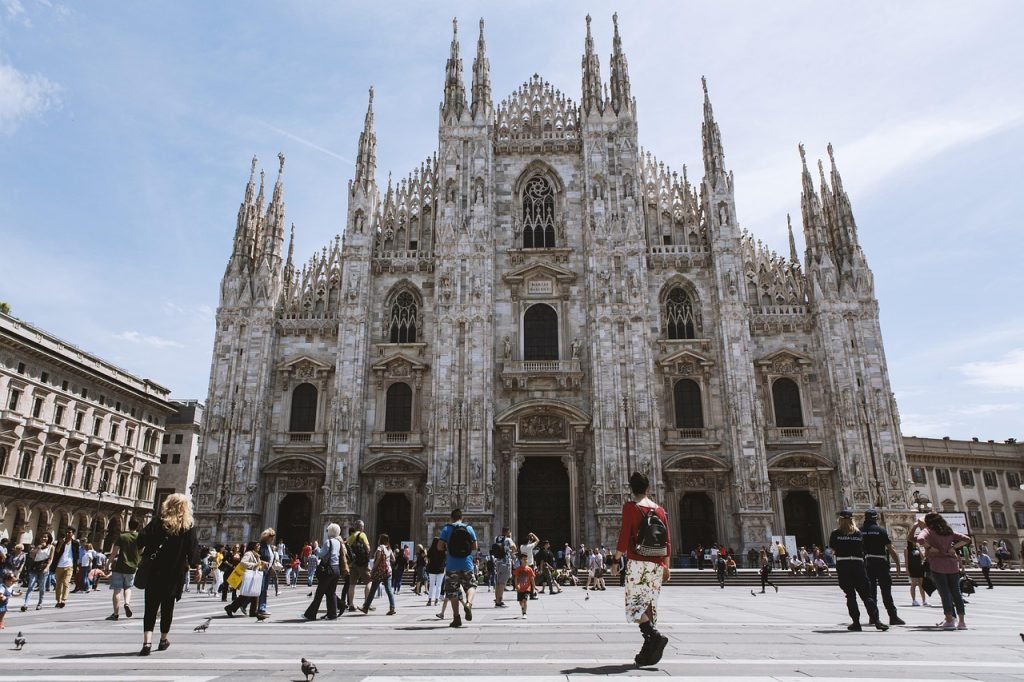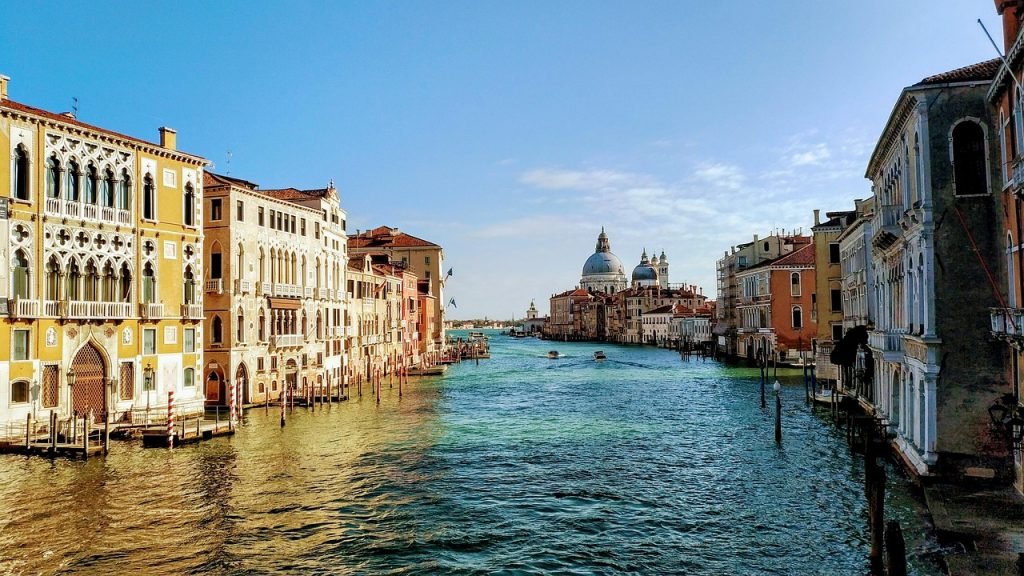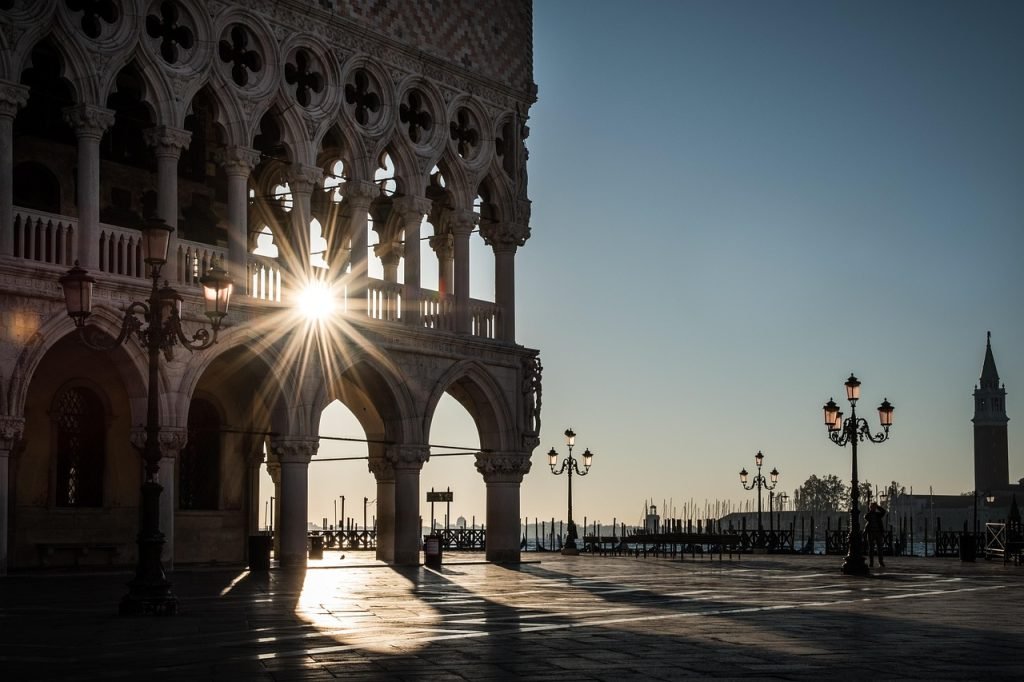Bene, you’ve decided to brave Milan despite my warnings about the chaos and expense. Smart choice, actually. Since you’re going anyway, let me make sure you experience the essential Milano – not just the overpriced tourist version, but the real deal that makes this concrete jungle Italy’s economic heart and cultural laboratory.
Here are 15 experiences that justify Milan’s place on your Italian itinerary, even if you’d prefer to be sipping wine in Tuscan hills.
1. Climb the Duomo Terraces at Sunset
Cost: €26 | Why it matters: This isn’t optional photography tourism – it’s a pilgrimage to understand Milan’s ambition made manifest in Gothic stone.
Standing among 3,400 statues and 135 spires while the city sprawls endlessly below, you’ll finally grasp Milan’s scale and determination. The craftsmanship is mind-bending – every gargoyle, every flying buttress represents centuries of devotion to creating something impossibly beautiful. Book online, arrive 90 minutes before sunset, and prepare for crowds. The view of the Alps on clear days reminds you that Milan sits at the crossroads of Europe.
Insider reality: Yes, €26 feels like highway robbery. But this is Milan’s crown jewel, and some experiences justify their price tags.
2. Master the Art of Aperitivo in Navigli
Cost: €8-12 per drink | Why it’s essential: This is where you’ll witness Milan’s daily transformation from work machine to social organism.
The Navigli canals, designed by Leonardo da Vinci himself, become Milan’s living room every evening from 6-8 PM. Find a spot along Naviglio Grande or Naviglio Pavese, order an Aperol Spritz or Negroni, and watch the theater unfold. Young professionals decompress, fashion students debate trends, entrepreneurs plot startups – all while sharing complimentary snacks that often constitute entire meals.
Local secret: Skip the touristy canal-front spots. Walk five minutes inland for better prices and more authentic crowds.
3. Hunt for Leonardo’s Last Supper
Cost: €25 | Why you must persist: Seeing one of art history’s most revolutionary masterpieces in person creates an almost religious experience.
Attenzione: booking requires military-level planning, often months in advance. But standing before this fresco, understanding how Leonardo revolutionized perspective and psychological drama in paint, witnessing how 500 years haven’t diminished its emotional power – this justifies every frustrating booking attempt.
Brutal honesty: The actual viewing lasts 15 minutes. Prepare for disappointment if you expect hours of contemplation, but prepare for transcendence if you open yourself to the experience.
4. Lose Yourself in Pinacoteca di Brera
Cost: €15 | Why it’s unmissable: This is where Italian artistic genius reaches its absolute peak in an intimate setting that makes the Uffizi feel like a stadium.
Caravaggio’s dramatic chiaroscuro, Raphael’s divine harmony, Mantegna’s heartbreaking “Dead Christ” – masterpieces that would headline any world museum sit here in contemplative dignity. But my favorite remains Francesco Hayez’s “The Kiss,” that passionate embrace symbolizing Italian Romanticism that still stops conversations mid-sentence.
Strategic tip: Visit Tuesday or Wednesday afternoons when crowds thin and natural light filters beautifully through gallery windows.
5. Experience La Scala (Museum and Performance)
Cost: Museum €15, performances €20-300+ | Why it defines Milan: This isn’t just opera – it’s where music becomes religion and Italian cultural prestige reaches its zenith.
The museum offers fascinating glimpses into opera history, but attending an actual performance transforms tourists into pilgrims. Even from affordable gallery seats, you’ll understand why this theater became the center of the musical universe. The acoustics are perfect, the atmosphere electric, the cultural weight profound.
Reality check: Performance tickets are expensive, but this is where Verdi, Puccini, and Toscanini created immortal magic that still reverberates through these hallowed halls.
6. Decode Fashion in the Quadrilatero della Moda
Cost: Free (window shopping) | Why it matters: Witness centuries of Italian craftsmanship evolution serving global luxury markets.
Via Montenapoleone, Via della Spiga, Via Sant’Andrea, Via Borgospesso – these streets aren’t just retail therapy, they’re anthropology. Watch impeccably dressed Milanesi navigate luxury like ballet dancers, observe how window displays change with religious frequency, marvel at architecture that makes shopping feel sacred.
Unexpected bonus: Many boutiques offer complimentary espresso to serious browsers, turning window shopping into cultural exchange.
7. Explore Castello Sforzesco’s Hidden Treasures
Cost: Castle grounds free, museums €5 | Why it’s underrated: This is where Milan’s Renaissance power brokers plotted, and where Michelangelo’s final masterpiece waits in humble magnificence.
The Sforza family castle houses treasures that would headline anywhere else: Michelangelo’s unfinished Rondanini Pietà, Egyptian collections rivaling major capitals, decorative arts spanning centuries. But what I love most is how the surrounding Parco Sempione breathes with daily Milanese life – joggers, lovers, families, nonne feeding pigeons.
Local perspective: This represents Milan’s layers – medieval foundations supporting Renaissance ambitions within contemporary urban life.
8. Discover Authentic Milan in Brera District
Cost: Free to wander | Why it’s magical: This is intellectual Milan, artistic Milan, the neighborhood where ideas ferment over wine and creativity flows like the nearby canals.
Cobblestone streets hide artist studios, antique shops, intimate restaurants perfecting the art of long lunches. This isn’t tourist Milan – it’s where painters, writers, and thinkers have gathered for centuries. The atmosphere feels more like Paris’s Montmartre than typical Italian tourist districts.
Perfect timing: Late afternoon when golden light filters through narrow streets and aperitivo culture begins stirring.
9. Marvel at Bosco Verticale and Porta Nuova
Cost: Free | Why it represents Milan’s future: These vertical forests aren’t just architecture – they’re environmental philosophy made manifest.
The contrast is stunning: medieval Duomo spires versus contemporary skyscrapers covered in thousands of plants purifying city air. This district represents Milan’s vision for sustainable luxury, where environmental consciousness meets cutting-edge design. It’s ambitious, bold, and thoroughly Milanese in its confidence.
Photography tip: The best views are from Corso Como area during golden hour when the towers’ greenery glows against glass and steel.
10. Hunt for Perfect Risotto alla Milanese
Cost: €15-25 per dish | Why it’s culturally essential: This is Milan’s signature contribution to Italian cuisine, and when done properly, it’s sublime comfort food elevated to art.
Real risotto alla milanese uses saffron, bone marrow, and patience. The rice should have texture, the flavor complex but comforting. Seek out traditional trattorias in Brera or around Porta Romana.
Warning: Tourist areas serve terrible versions. Look for restaurants where the staff speaks more Italian than English. Trattoria La Colonna is a good place to go.
11. Experience Milan’s Coffee Culture Properly
Cost: €1.20 per espresso | Why it’s fundamental: Milan’s relationship with coffee borders on spiritual, and understanding it unlocks daily Italian social rituals.
Stand at the bar (never sit unless you want to pay double), order “un caffè” (never “espresso” – that’s tourist talk), drink it quickly while engaging in brief social interaction, then continue your day. This micro-ritual happens millions of times daily and maintains Milan’s social fabric.
Cultural note: Cappuccino after 11 AM marks you as foreign. Embrace the judgmental stares or stick to espresso.
12. Shop at Navigli Antique Markets
Actually, hunt for vintage treasures at Navigli Antique Markets on the last Sunday of each month. This is where Milan’s fashion-obsessed population recycles luxury, where yesterday’s Versace becomes today’s vintage treasure. The quality is extraordinary, the prices still high but reasonable for designer pieces.
Strategy: Arrive early for best selection, bring cash for negotiations, and prepare for serious fashion competition from locals who know their labels.
13. Take the Tram 1
Take Tram Line 1 through Milan’s heart from Porta Genova to Cairoli, passing major landmarks while experiencing how locals actually navigate the city. It’s practical transportation that doubles as sightseeing, offering glimpses into daily Milanese life beyond tourist bubbles.
Local wisdom: Buy day passes (€4.50) rather than single tickets, and always validate or face hefty fines from aggressive controllers.
14. Explore Sant’Ambrogio Basilica and Surrounding Area
Cost: Free | Why it’s spiritually essential: This 4th-century basilica represents Milan’s religious foundation, named after the city’s patron saint who defended Christianity when Rome was still pagan.
The Romanesque architecture feels ancient and powerful, the atmosphere contemplative after Duomo crowds. The surrounding neighborhood offers authentic Milanese daily life – local markets, neighborhood bars, residents who’ve lived here for generations.
Reflection moment: This is where Milan’s spiritual identity lives, separate from commercial tourism and fashion week madness.
15. Survive (and Embrace) the Chaos of Porta Garibaldi
Cost: Free trauma | Why it’s quintessentially Milan: This transportation hub and business district embodies everything simultaneously wonderful and maddening about Milan.
Streams of commuters, tourists, business people, and street vendors create constant human rivers flowing in every direction. It’s overwhelming, exhausting, and completely authentic. This is Milan’s pulse made visible – relentless energy channeled through infrastructure that somehow, miraculously, functions.
Survival tip: Flow with the crowd, keep belongings secure, and appreciate the organized chaos that keeps Italy’s economic engine running. Be aware of pickpockets.
The Honest Summary: Why These 15 Matter
These aren’t just tourist attractions – they’re windows into Milan’s complex soul. Each experience reveals different layers: medieval foundations, Renaissance ambitions, industrial determination, contemporary innovation, and global aspirations all compressed into one incredibly expensive, chaotic, essential Italian city.
Budget reality: Experiencing all 15 properly requires €150-200 per person plus meals. Yes, it’s more than you’d spend in Florence or Rome, but you’re accessing Italy’s economic and cultural laboratory.
Time needed: Three full days minimum to experience these without feeling rushed. Milan rewards patience despite its frantic pace.
Final truth: You might not fall in love with Milan like you would with Venice or the Tuscan countryside. But you’ll understand modern Italy in ways impossible anywhere else. And sometimes, understanding matters more than romance.
Milan doesn’t want to be loved – it wants to be respected. Give it that respect, experience these 15 essential moments, and you’ll leave with stories no other Italian destination could provide.
Basta così – now go survive Milan with style, armed with realistic expectations and genuine appreciation for what makes this impossible city indispensable.


